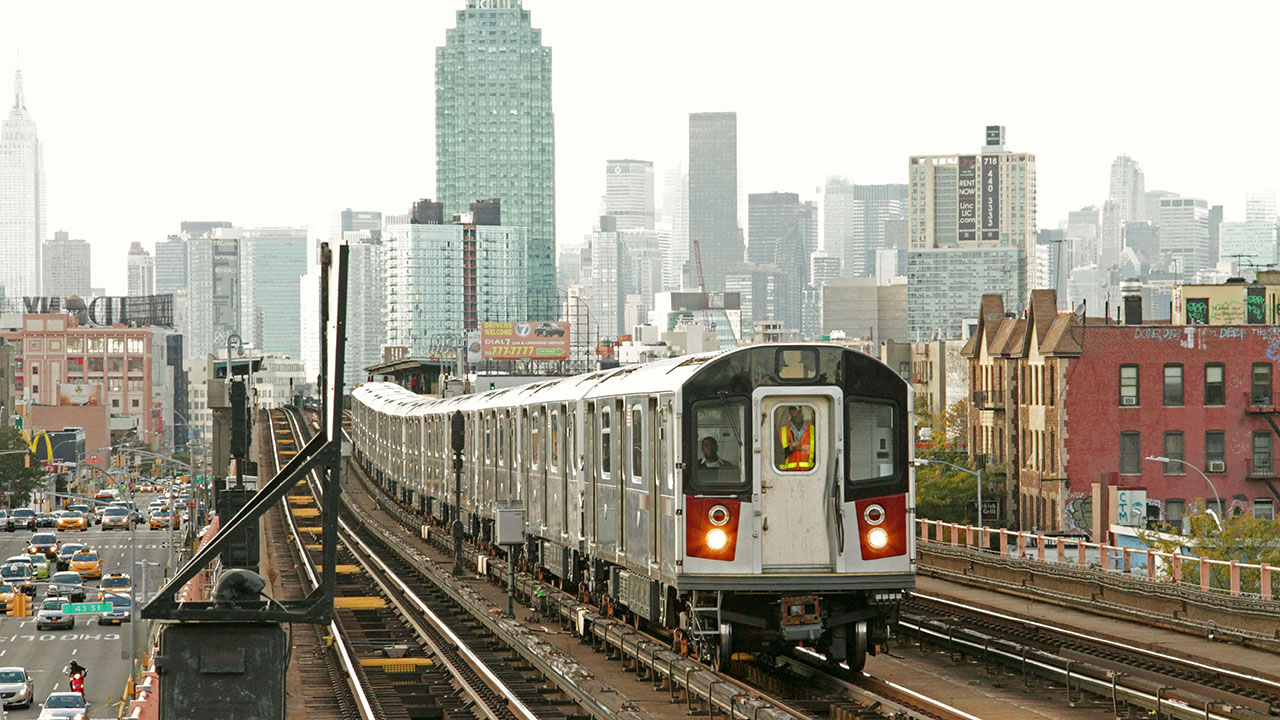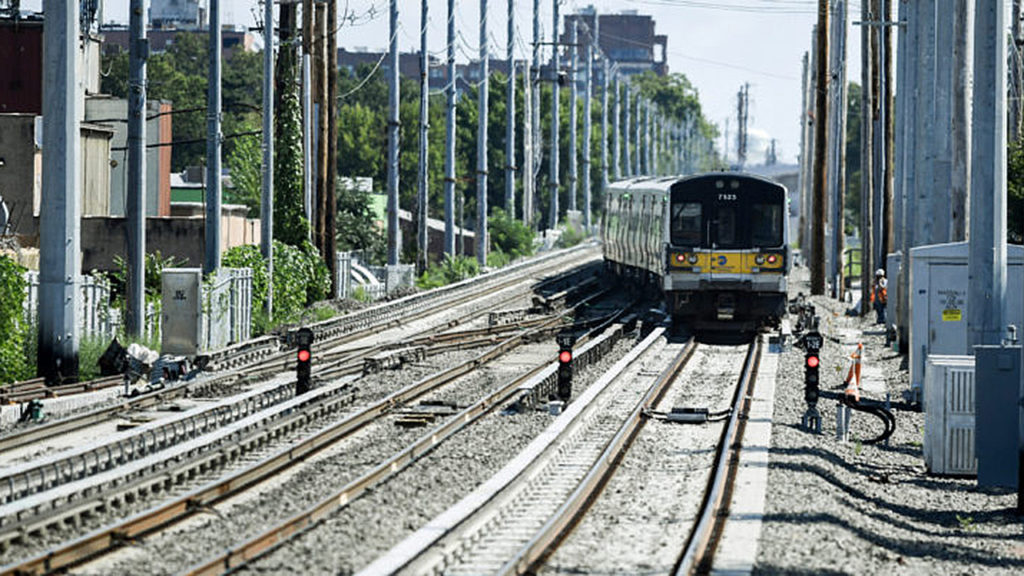
Metropolitan Marvel
Written by William C. Vantuono, Editor-in-Chief
NYC Transit's R-188 CBTC test train on a weekend day testing on the center track. Joseph M. Calisi photo.
RAILWAY AGE, OCTOBER 2022 ISSUE: The world’s biggest transit agency is bouncing back, in a big way.
The New York Metropolitan Transportation Authority (MTA) is the world’s largest, with operating and capital budgets that rival those of Class I railroads, and ridership on its giant rapid transit network, MTA New York City Transit, and two regional/commuter rail systems, MTA Metro-North Railroad and MTA Long Island Rail Road (LIRR), of some two billion trips, annually.
Those impressive numbers, of course, are pre-COVID-19. Ridership fell off a cliff, as expected, during the pandemic, but is making a steady recovery. The MTA has benefitted from a major infusion of federal pandemic relief funds, much of it for operations, but that money will be exhausted within the next couple of years. But major capital programs, financed through the agency’s five-year plans, as well as federal dollars, are making steady progress, boosted now by funds from the Biden Administration’s IIJA (Infrastructure Investment and Jobs Act), also known as BIL (Bipartisan Infrastructure Law).
Following are several examples of how the MTA, truly a “metropolitan marvel,” is building for the future—with BIL helping pay the bills—to create a more-cohesive, unified system with multiple route options, and greater flexibility and resiliency.
Grand Central Madison
The LIRR’s $11.1 billion project to bring service to Manhattan’s East Side is expected to start by the end of this year. Riders will travel to a new 700,000-square-foot LIRR terminal, which is virtually complete and now called Grand Central Madison.
Construction of what had been called the East Side Access (ESA) project—originally conceived in the 1960s and developed in the 1990s—began in 2006, and represents the largest expansion of LIRR service since the original Pennsylvania Station and its East River Tunnels opened Sept. 8, 1910. The project includes Grand Central Madison, located under Grand Central Terminal, which currently serves MTA Metro-North Railroad and MTA New York City Transit. The new connection is expected to double LIRR capacity into Manhattan, with up to 24 trains per hour, and cut travel time for Queens, N.Y., riders by 40 minutes per day.
LIRR trains will approach Grand Central Terminal through a new double-track tunnel under the East River at 63rd Street. The two tracks double to four and again to eight on Grand Central Madison’s two levels. Grand Central Madison includes more than 40 track-miles and nearly 13 miles of newly excavated tunnels, with 44 ventilation fans, 550 miles of cable, 975 security cameras, 15 overhead wayside signal structures, and 14 signal bungalows. A new yard in Queens has been built to accommodate up to 300 railcars, and LIRR’s Harold Interlocking has been updated, including installation of 97 new turnouts, 295 catenary poles used by Amtrak, five new steel railroad bridges, and 8,445 feet of retaining walls.
Metro-North Penn Station Access
The Metro-North Penn Station Access project is something that has been discussed (some say argued over) for years by LIRR, Metro-North, NJ Transit and Amtrak. But, now, the “territory squabbles” have been mostly worked out. In 2019, Amtrak’s Board of Directors approved an agreement with the MTA that paved the way for the new service. RailWorks Transit LLC, in a joint venture with Halmar International, has been awarded the design-build contract.
The project will bring Metro-North commuter rail service to Penn Station and Manhattan’s West Side, along Amtrak’s Hell Gate Line on the Northeast Corridor, giving riders a choice between that and Grand Central Terminal. Also included in the project are four new stations in the East Bronx—at Hunts Point, Parkchester, Morris Park and Co-Op City—which would be part of the New Haven Line. At Penn Station, riders from Connecticut, Westchester and the Bronx would be able to connect with LIRR, New Jersey Transit, Amtrak, Port Authority Trans-Hudson Corp. (PATH), and MTA New York City Transit subway and bus services. According to MTA, the commute from Co-op City to Penn Station would be reduced from 75 to 25 minutes, and the commute from Hunts Point to Penn Station would be cut from 45 to 16 minutes.
Working in partnership with Halmar, RailWorks Corporation’s New York-based transit division, RailWorks Transit LLC, will design and construct additional passenger tracks, traction power substations, overhead contact systems, new interlockings, updated communication systems, and new signal systems within Amtrak’s right-of-way. The contract also includes construction of the four new Metro-North stations, which will bring increased regional accessibility to the eastern Bronx communities.
Metro-North Penn Station Access, slated for completion in 2027, “will expand service options and accessibility for hundreds of thousands of Metro-North commuters,” RailWorks President and CEO Kevin Riddett said. “RailWorks is proud to partner with Halmar International on this crucial project, and we look forward to seeing it fully completed”—as will thousands of Metro-North customers who work on the West Side of Manhattan
LIRR Third Main Line Track

The LIRR opened the 2.5-mile second section of its new Main Line Expansion (Third Track) project between the Merillon Avenue and Mineola stations on Aug. 29. “Just two weeks after opening the first section of the Third Track (Floral Park to Merillon Avenue), we’re celebrating the next step in the MTA’s historic, multi-billion-dollar investment into the LIRR,” said MTA Chair and CEO Janno Lieber. “Third Track, along with Grand Central Madison, will allow the LIRR to increase service by 40%.”
MTA noted that this project is “a major part of an unprecedented multi-billion-dollar investment in 100 projects to transform and modernize the LIRR” that also includes Grand Central Madison; construction of a more spacious Penn Station LIRR Concourse and a new entrance at 33rd Street; renewal and upgrading of 36 stations and 17 bridges; elimination of eight at-grade railroad crossings; addition of 13 miles of second track between Farmingdale and Ronkonkoma; upgrades to 15 electrical substations; parking capacity increases; and railyard expansions.
NY PENN RECONSTRUCTION
Moynihan Train Hall, the second phase of the larger New York Penn Station Reconstruction project, will, after years of fits and starts punctuated by political squabbles, finally open for LIRR and Amtrak service Jan. 1. The $1.6 billion project, which renovated the 100-year-old James A. Farley Post Office Building at 8th Avenue across from Penn Station, wraps up Dec. 31. Named for the late U.S. Sen. Daniel Patrick Moynihan, who represented New York for 24 years and championed the project, it expands Penn Station’s concourse space by 255,000 square feet, or 50%.
New York Penn Station Reconstruction’s first phase, completed in 2017, included a new $300 million, 400-foot-by-400-foot concourse with direct access to the western end of platforms for 17 of Penn Station’s 21 tracks. Moynihan Trail Hall, a public-private partnership among Empire State Development, Vornado Realty Trust, Related Companies, Skanska, LIRR, Amtrak, and the Port Authority of New York and New Jersey, has been delivered via a design-build partnership.
A design and engineering contract to complete New York Penn Station Reconstruction has gone to a joint venture led by FXCollaborative Architects LLP and WSP USA Inc., with British architect John McAslan + Partners as a collaborator. MTA, in partnership with NJ Transit and Amtrak, announced approval of the contract on Sept. 21. The RFP was released in June.
The FXCollaborative and WSP joint venture developed the Penn Station Master Plan, which was unveiled last year. It evaluated alternatives and created the preferred redesign plan for Penn Station as a single-level facility centered around a train hall with a 450-foot long sky-lit atrium between Madison Square Garden and 2 Penn Plaza. The design “will relieve overcrowding and improve passenger flow and orientation; improve safety by increasing platform and station egress and accessibility; alleviate the ‘cramped, disjointed circulation areas with widened concourses and high ceilings’; create a clear street presence that integrates with the surroundings”; optimize retail and other revenue generation; and integrate Penn Station with Moynihan Train Hall and the planned Penn Station expansion,” MTA said.
The recommendation for the design joint venture followed an open, competitive RFP process that attracted five proposals from firms and joint ventures that were reviewed and scored by representatives from MTA Construction & Development, Amtrak and NJ Transit, and assisted by a Technical Advisory Committee with additional representatives from LIRR, Empire State Development and the New York City Economic Development Corp.
A base contract of up to $57.9 million will develop the preliminary station design and will last for one year. This contract includes options covering preliminary design for improvements to nearby NYCT subway stations, and design and engineering support as the station reconstruction moves forward. Additionally, MTA’s Department of Diversity and Civil Rights assigned a 22.5% DBE (Disadvantaged Business Enterprises) goal to the contract.
“We are excited to recommend a team that has a track record of designing projects that achieve world-class design excellence while improving safety and being constructible, our singular focus as we seek to finally give Penn Station’s 600,000 daily riders the station they deserve,” MTA C&D President Jamie Torres-Springer said.
“The work will take place on an aggressive timetable,” Janno Lieber added. “The opening of Grand Central Madison provides us with a once-a-century opportunity to rebuild Penn Station. With a sizable percentage of LIRR riders expected to shift their trips to Grand Central Madison, Penn Station will have five years with lower customer volumes before a new influx of customers arrives on Metro-North by 2027. The MTA wants to get the most disruptive of the work done before then, so I’m thrilled we are moving forward quickly with the design phase of this massive, long-delayed effort.”
The full project is estimated to take five to six years to complete and comes with a price tag of $6-$7 billion.


